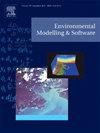Multivariate functional data analysis and machine learning methods for anomaly detection in water quality sensor data
IF 4.8
2区 环境科学与生态学
Q1 COMPUTER SCIENCE, INTERDISCIPLINARY APPLICATIONS
引用次数: 0
Abstract
Reliable anomaly detection is crucial for water resources management, but the complexity of environmental sensor data presents challenges, especially with limited labeled data in water quality analysis. Functional data has experienced significant growth in anomaly detection, but most applications focus on unlabeled datasets. This study assesses the performance of multivariate functional data analysis and compares it with current machine learning models for detecting water quality anomalies on 18 years of expert-annotated data from four monitoring stations along Spain’s Ebro River. We propose and validate a multivariate functional model incorporating a new amplitude metric and a nonparametric outlier detector (Multivariate Magnitude, Shape, and Amplitude–MMSA). Additionally, a Random Forest-based machine learning architecture was developed for the same purpose, employing sliding windows and data balancing techniques. The Random Forest model demonstrated the highest performance, achieving an average F1 score of 93%, while MMSA exhibited robustness in scenarios with limited anomalous data or labels.

水质传感器数据异常检测的多元函数数据分析与机器学习方法
可靠的异常检测对水资源管理至关重要,但环境传感器数据的复杂性带来了挑战,特别是在水质分析中标记数据有限的情况下。功能数据在异常检测方面经历了显著的增长,但大多数应用都集中在未标记的数据集上。本研究评估了多元函数数据分析的性能,并将其与当前的机器学习模型进行比较,该模型用于检测西班牙埃布罗河沿岸四个监测站18年来专家注释的水质异常数据。我们提出并验证了一个多元函数模型,该模型结合了一个新的幅度度量和一个非参数离群值检测器(多元幅度、形状和幅度- mmsa)。此外,为了同样的目的,基于随机森林的机器学习架构被开发,采用滑动窗口和数据平衡技术。随机森林模型表现出最高的性能,平均F1得分为93%,而MMSA在异常数据或标签有限的情况下表现出鲁棒性。
本文章由计算机程序翻译,如有差异,请以英文原文为准。
求助全文
约1分钟内获得全文
求助全文
来源期刊

Environmental Modelling & Software
工程技术-工程:环境
CiteScore
9.30
自引率
8.20%
发文量
241
审稿时长
60 days
期刊介绍:
Environmental Modelling & Software publishes contributions, in the form of research articles, reviews and short communications, on recent advances in environmental modelling and/or software. The aim is to improve our capacity to represent, understand, predict or manage the behaviour of environmental systems at all practical scales, and to communicate those improvements to a wide scientific and professional audience.
 求助内容:
求助内容: 应助结果提醒方式:
应助结果提醒方式:


